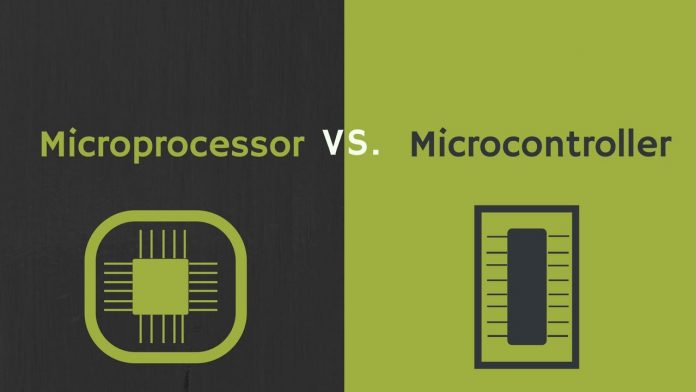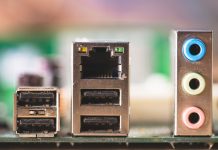The Microprocessor helps in performing the commands of computer processing. The Microcontroller is the compact integrated circuit that performs the particular operations in the embedded systems.
We use both the Microprocessor and the Microcontroller for the real-time application. Though the difference between microprocessor and microcontrolleror the MPU sound similar, they also share a lot of dissimilarities. The Microprocessor and the Microcontroller may often create confusion for you.
Are you interested in clarifying your confusion? Are you willing to know the differences between the Microprocessor and the Microcontroller? Of course, you’ll be. Let’s start your journey with us to explore the differences between Microprocessor and Microcontroller.
Table of Contents
What is a Microprocessor?
The Microprocessor is one of the significant components of the computer procession. It is the fundamental unit of the computer system. You may use the Microprocessor to perform the directions and the activities of computer processing. You may also call it the Central Processing Unit or the processor. It is also familiar as a logic chip. The Microprocessor assists you in performing the logical instructions and arithmetic operations. It helps to transform data from one memory location to another memory location.
The Microprocessor is a multipurpose device. It is also a programmable device which is the most vital unit of your computer. Through the Microprocessor, your computer performs all your instructions and commands. You may compare the Microprocessor to the brain of the computer system. When you switch on your computer, it starts to perform its duty. The special and the particular design of the Microprocessor enable it to execute all the computational activities. You may consider it as the heart of the computer.
What is a Microcontroller?
The Microcontroller is also a crucial device of the computer. It is also familiar as the Integrated Circuit (IC) device. Another name of this device is the MCU. It assists in performing the specific application and one single task. The electronic devices which are do not need to control use the Microcontroller. The Microcontroller enables the automatically controlled devices to perform its functions.
Your camera, mobile phone, washing machine, and other electronic devices contain the Microcontroller to perform their respective task automatically. Your car also comprises of hundreds of Microcontrollers. Each of the Microcontrollers performs its specific functions. The Microcontroller enables the remote control toys to move automatically. The Microcontroller contains memory, a Microprocessor, and some circuits.
What are the Differences between the Microprocessor and the Microcontroller?
The Microprocessor and the Microcontroller sometimes create misperceptions as they belong to the same device. But they are not able to replace each other. That means they have different respective functions. The Microprocessor and the Microcontroller are not similar. The Microcontroller contains Microprocessor.
But there are vast differences between the Microprocessor and the Microcontroller. One is the core of the central processing unit, and another is the byproduct of the improvement of that central processing unit. The Microprocessor performs as the intellect of the digital devices. On the other hand, the Microcontroller enables the automatic functions in the electric devices. We’ll mention some differences between the Microprocessor and the Microcontroller in the next section.
Components of the Microprocessor VS the Microcontroller:
The Central Processing Unit is the center of the brain of the computer system. The Microprocessor is the fundamental component of the Central Processing Unit or the CPU. It possesses one single Microprocessor or more than one. The parts of the Microprocessor and their activities are listed below:
- A Microprocessor consists of millions of transistors.
- There is an Arithmetic Logic Unit or the ALU to execute all the mathematical calculations.
- The Microprocessor also contains some registers. Registers are the data storage space by which you can maintain your data.
- The Microprocessor also contains some bus systems. The bus system helps data to move from the Central Processing Unit CPU to the Random Access Memory or the RAM.
- The most improved Microprocessor also possesses the Cache Memory. You can use this Cache Memory to recollect the previously used data by your CPU.
- It also has a Control Unit.
The Microcontroller is a powerful device which helps to control the electronic devices automatically. The components of the Microcontroller are different from the Microprocessors. The elements of the Microcontroller and their functions are –
- The Microcontroller contains the Central Processing Unit or the CPU, which assists in performing arithmetical calculations and data-oriented tasks.
- It contains the timers to perform the automatic functions. The Counters and the Timers are very crucial components for the Microcontroller.
- The Microcontroller offers you the Random Access Memory as the data memory. You may also call it the Read Write Memory. It stores the data temporarily to aid you during the execution of your command.
- It also provides the Read-Only Memory as the Program Memory. You can store your programs in this memory.
- The Microcontrollers have the I/O Ports to provide the interface to the exterior world.
- Like the Microprocessor, the Microcontroller also contains some system busses. The system establishes with wires which create the connection between the Central Processing Unit and other components.
- The Microcontroller has internal or external interrupts. The interrupts are very crucial for the Microcontroller. You may find interrupts related to the software or the hardware.
- It uses the serial ports to maintain serial communications.
Structural differences between the Microprocessor and the Microcontroller:
The structures and the elements of the Microprocessor and the Microcontroller are not the same. So the purchasing costs of these two devices are also different. You have to spend more money on the Microprocessor comparing to the Microcontroller.
Both the Microprocessor and the Microcontroller comprises metal-oxide-semiconductor or the MOS. But the Microprocessor contains a lot of external components, which increases its costs.
Comparing to the Microprocessor, the Microcontroller uses fewer external components. So it is cheaper than the Microprocessor. In the case of the primary structural peripherals, the Microprocessor and the Microcontroller are different. The peripherals of the Microcontroller are in the compact chip. But if you observe the Microprocessor, you’ll find the chip as a heavy one.
Are the speeds of the Microprocessor and the Microcontroller Same?
Are you wanted to know about the speed of the Microprocessor and the Microcontroller? If yes, then think about their structures and the elements. If all the components are different, then how can the processing speed be the same? However, we have already mentioned the parts, and the structures of the Microprocessor and the Microcontroller is different. Their processing speeds are also different.
The processing agility of the Microprocessor is more than the processing speed of the Microcontroller. You’ll find the Microprocessor functions more than the rate of 1 GHz. On the other hand, the Microcontroller performs its task about 8 MHz- 50 MHz of speed. The processing speed of the Microcontroller is lesser than the Microprocessor. So, it works slower than the Microprocessor.
Do the Microprocessor and the Microcontroller Use Same Power?
Do the Microprocessor and the Microcontroller use the same amount of power to execute their functions? The question may come to your mind now. The answer is no. The fact is the Microprocessor spends more power than the Microcontroller.
The Microprocessor does not possess any power saving system. So it is unable to save energy. The Microprocessor also contains a lot of exterior components. All of these external elements also consume power. So the overall consumption of the power of the Microprocessor is pretty high.
On the contrary, the Microcontroller offers you the power saving mood. By saving power, it can limit its consumption of energy. Like the Microprocessor, the Microcontroller does not have the external components. So, the use of Microcontroller power is less compared to the consumption of the Microprocessor.
What are the Functions of the Microprocessor and the Microcontroller?
The Microprocessor and the Microcontroller perform different types of tasks. It acts as the brain of the computer. The functions of the Microprocessor are –
- The Microprocessor helps to control the overall performances of the Central Processing Unit or the CPU. It manages the functions of your computer or other electronic devices.
- The Microprocessor executes its functions through the data memory and program memory.
- The Microprocessor fixes the commands with the assist of the Read-Only Memory. It gets the orders from the central memory.
- The Microprocessor decodes the commands to get the meaning of the instruction.
- Then it collects the data from the I/O port and the central storage.
- After collecting the essential data, it starts to execute them.
- It also controls the I/O devices. It responses to the interrupts and resumes the present program.
The functions of the Microprocessor and the Microcontroller are different from each other. But the roles of both are essential for the computer system and the electronic devices. The functions that a Microcontroller execute are –
- The Microcontroller enables electronic devices to move automatically.
- It also responses to the interrupts. When it gets the request of the interruption, it stops its current program. Then it performs another subprogram.
- The Microcontroller can maintain the digital and the analog signs on the single chip. It is also able to mingle the digital and analog signs. By mixing these two signals, it increases flexibility.
- It also offers you the external reset function. It deletes the information on the storage and starts over its program.
- It can solve the signal transition problems through the aid of the Switch Debouncer option.
Different Advantages of the Microprocessor and the Microcontroller:
Both the Microprocessor and the Microcontroller are an essential part of the computer system. They perform different functions. So they also benefit us differently. The advantages of the Microprocessor are –
- The Microprocessor is capable of performing its function at a higher speed. You have to measure the processing speed of the Microprocessor in Gigahertz or GHz.
- Through the Microprocessor, you can perform about 3 billion of tasks in a second. The Microprocessor is also capable of transforming the data between various storage spaces.
Microcontrollers also have many benefits. The advantages of the Microcontrollers are –
- The Microcontrollers are small, light, and compact. You can embed the Microcontroller to any device.
- It does not have external components. So the consuming rate of power of the Microcontroller is low. It saves energy through the power saving system.
- It is not so expensive and complicated. You may quickly learn the programming of the Microcontroller. It is easy to learn.
- With the assist of the Microcontroller, you may use simulators to observe the outcomes of your programs.
- The Microcontroller provides electronic automation systems.
What are the Disadvantages of the Microprocessor and the Microcontroller?
Though the Microprocessor and Microcontroller are vital devices for the computer, they have some disadvantages. The disadvantages of the Microprocessor –
- The main problem with the Microprocessor is its high cost. It contains various external elements that increase the expense of the Microprocessor.
- The exterior components also consume power. So, the energy consumption rate of the Microprocessor becomes very high.
- The Microprocessor is thick and bulky.
- It does not consider the errors of the programs. It is unforgiving towards the fault of the programs.
- The Microprocessor is devoid of any common sense.
- The design of the Microprocessor is a time-consuming matter.
Like the Microprocessor, the Microcontroller also has some disadvantages. The followings are the disadvantages of the Microcontroller-
- Comparing to the Microprocessor, the Microcontroller has a more complicated architecture. So, you’ll face difficulties in comprehending their functions.
- It is not directly able to interface high power devices.
- It cannot execute various tasks at a time.
- The development time of the Microcontroller rises because of the complications of the circuit board.
- The power processing system of the Microcontroller is limited.
- It will not be able to offer data storing.
- The ADC also limits it.
Final Thoughts:
Your computer or digital devices depend on the Microprocessor and Microcontroller. The two essential parts often create confusion. The differences mentioned above of the Microprocessor and Microcontroller can clarify the ambiguities. Tell me about your feelings about these two devices. Are the Microprocessor and Microcontroller still confusing to you? Please give me your feedback about these two different fundamental devices of your computer system. I’ll be waiting for your feedback. Till the moment, goodbye, friends.








